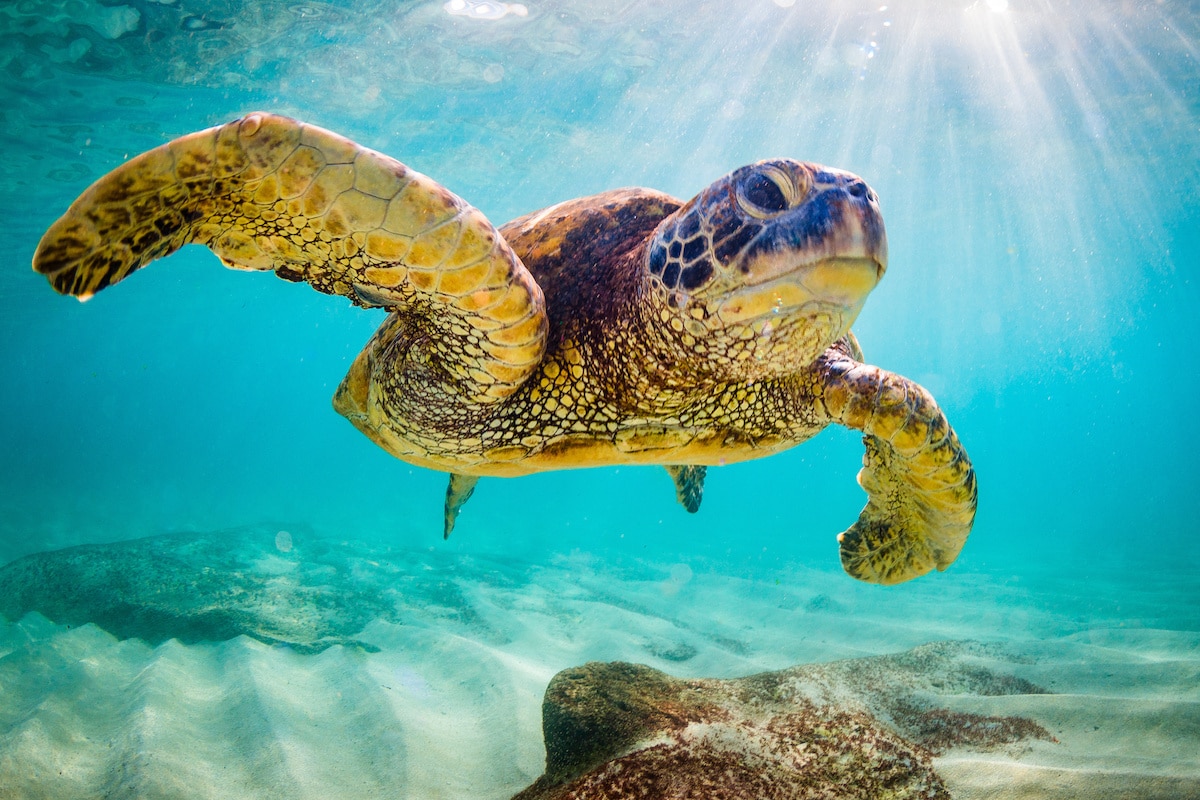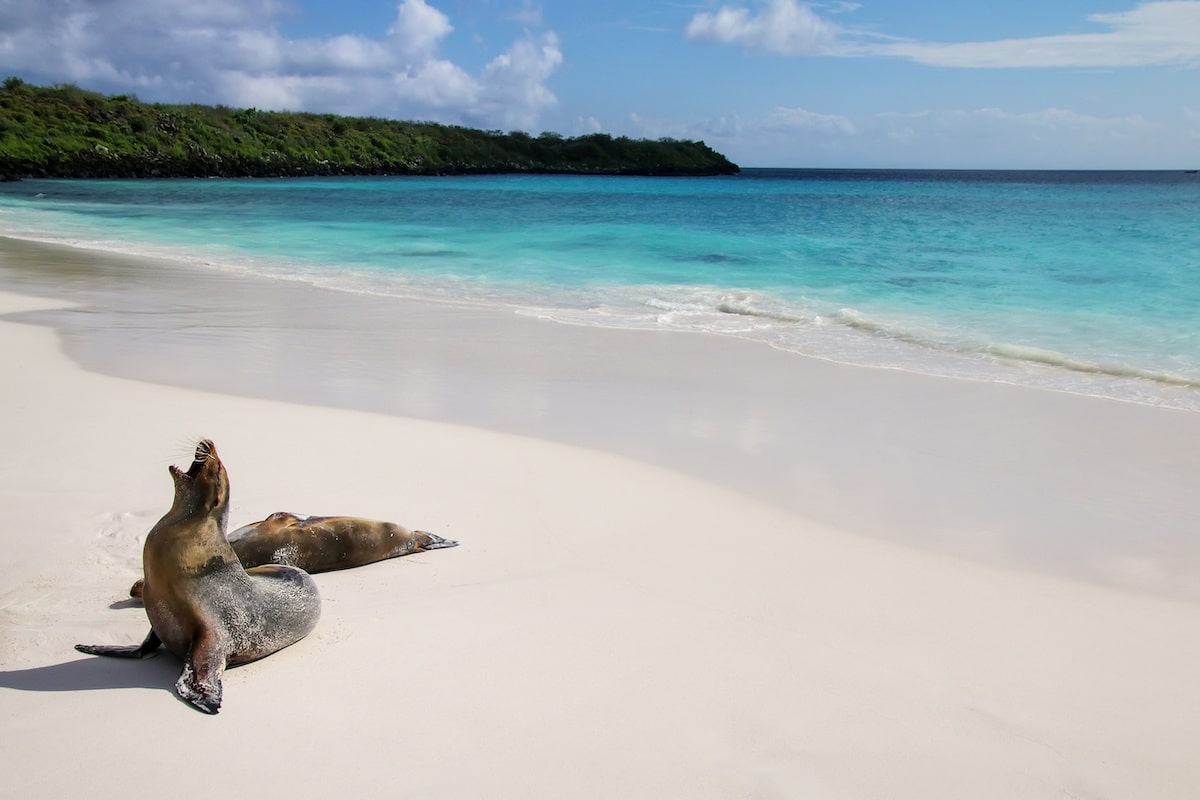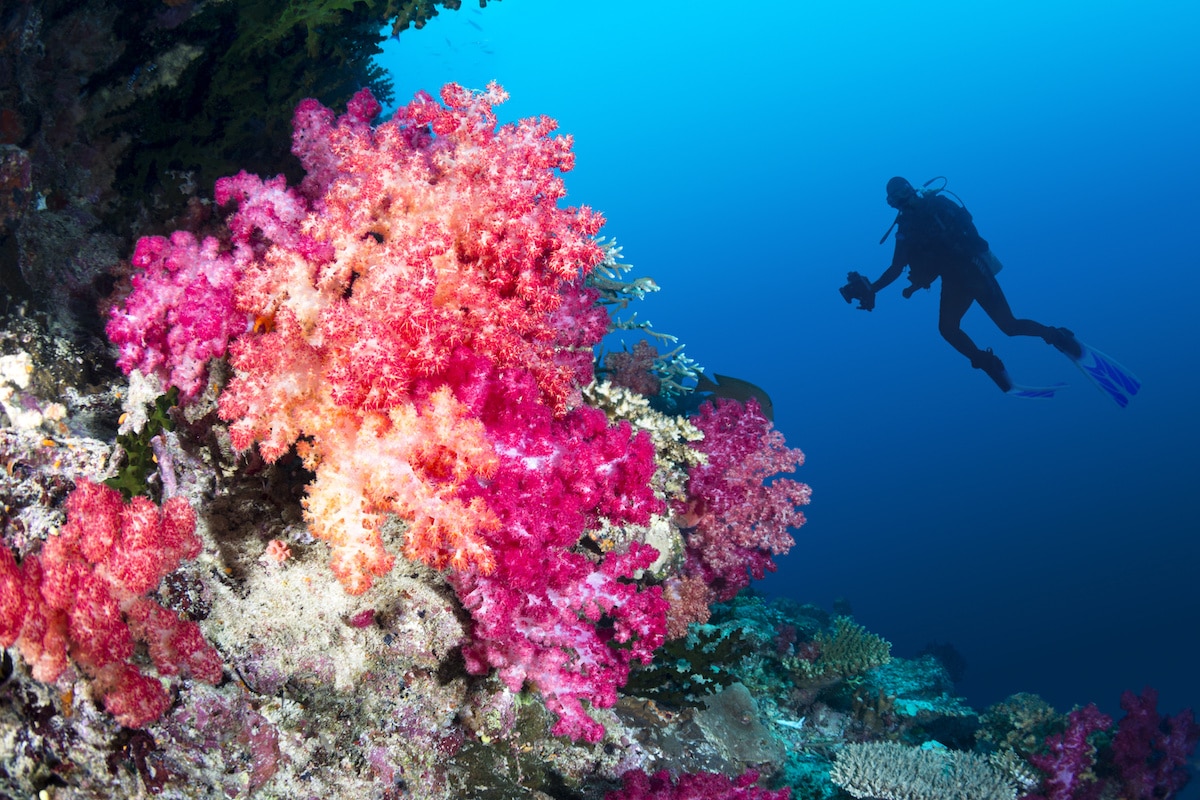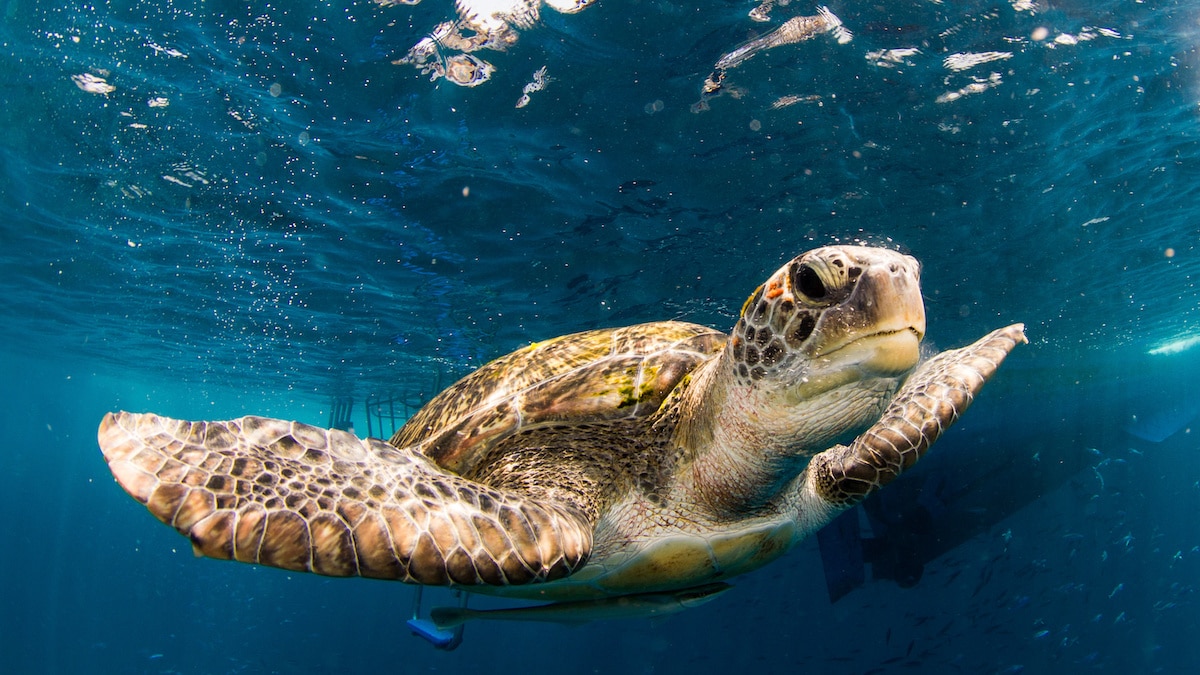News
Love sea turtles? Here’s 10 of the best places to dive with them!

Is there anything better than diving with sea turtles? These ancient animals are ever-popular with divers and you can find them at top dive destinations around the world.
Whether you want to dive close to home or further afield, there’s a turtle hotspot waiting for you.
Here are our top 10 places to go sea turtle diving.
1. Galapagos Islands
This epic dive destination is teeming with wildlife above and below the waterline. As well as giant Galapagos tortoises, you can also spot unique Galapagos green turtles at these special islands.

This subspecies of the green sea turtle is recognisable by the slightly darker, more domed shell and serrated lower jaw.
Go Galapagos diving at Punta Vicente Roca, on the northwest coast of Isabela Island, and you’ll see plenty of Galapagos green turtles hanging out there.
- Nesting season: December to March
- Hatching season: February to May
- Liveaboard top choice: Nortada
2. Hawaii
Hawaii is no stranger to top dive destination wish lists thanks to its lava landscapes and abundant marine life, including numerous species found nowhere else on Earth.
Hawaii’s rich waters host 5 of the 7 species of sea turtle, with Hawaiian green and hawksbill turtles commonly seen.
You can spot green sea turtles at various places, including Maui and Oahu. Leatherback, loggerhead and olive ridley turtles are also sometimes seen.
- Nesting season: May to October
- Hatching season: July onwards up to late December
- Liveaboard top choice: Kona Aggressor II
3. Great Barrier Reef, Australia
The Great Barrier Reef is one of the best places to see numerous sea turtles; at Raine Island in the far northern reefs.
This important sea turtle nesting area host tens of thousands of green sea turtles each year during their breeding season.

Image: Mike Ball Dive Expeditions
Go northern Great Barrier Reef scuba diving and you can see plenty of turtles in the waters surrounding Raine Island, plus at Ribbon and Osprey reefs further south.
- Nesting season: November to January
- Hatching season: January to March
- Liveaboard top choice: Spoilsport for Turtle Spectacular Northern Reefs safaris
4. Egypt
Seagrass beds are one of the best places to spot grazing green sea turtles, whereas Hawksbill turtles are more commonly seen feeding at reefs.

If you go Egypt diving, make sure you visit Abu Dabbab Bay at Marsa Alam. The seagrass beds there are known for encounters with dugongs and green sea turtles.
The reefs along Hurghada are a good place to spot Hawksbill turtles.
- Nesting season: July to August
- Hatching season: September to November
- Liveaboard top choice: Emperor Elite
5. Fiji
Known for its colourful soft corals, Fiji has idyllic reef diving, white-sand beaches and plenty of sea turtles.

Fiji’s paradise islands host 5 of the 7 species of sea turtle, including green, hawksbill, leatherback, loggerhead and olive ridley.
The coral bommies at Makongi Island and sheer walls of the Wakaya Pass are two of many places you can find turtles there.
- Nesting season: November to January
- Hatching season: January onwards
- Liveaboard top choice: Nai’i
6. Oman
Oman is off the radar for most divers, yet this warm water destination has an array of marine species and thriving reefs without any dive crowds.
The beaches of Oman are known for their nesting turtles and are visited by hawksbill and green sea turtles.
Whether you choose to dive the Daymaniyat Islands, Hallaniyat Islands or Musandam Peninsula, you’re likely to bump into sea turtles going out their day on the reefs.
- Nesting season: May to September
- Hatching season: July onwards
- Liveaboard top choice: Oman Aggressor
7. Thailand
The Similan Islands have some of Thailand’s best dive sites as well as green and hawksbill sea turtles.
As you dive the Similan Islands you’ll be among submerged boulders, thriving reefs and rock formations busy with reef life.

Just remember to look up for sea turtles and out to the blue for passing mantas and whale sharks.
- Nesting season: October to March
- Hatching season: December onwards
- Liveaboard top choice: Similan Explorer
8. Seychelles
The Seychelles has diverse diving at two main island groups, the Inner and Outer Islands.
These dramatically different island groups offer granite landscapes dotted with boulders and drop-offs, plus remote diving at coral atolls and reef islands.
Alphonse Island in the remote Outer Islands hosts nesting green and hawksbill turtles and is well worth visiting for pristine reef diving as well.
- Nesting season: September to March (hawksbill), January to September (green)
- Hatching season: November onwards (hawksbill), March onwards (green)
- Liveaboard top choice: Galatea
9. Cayman Islands
Known for its crystal-clear waters and over 350 dive sites, the Cayman Islands are a dream destination for reef, wall and wreck diving fans.
The warm waters also host loggerhead, green and hawksbill turtles, with plenty of turtles seen at Grand Cayman.
- Nesting season: April/May to November
- Hatching season: July to November
- Liveaboard top choice: Cayman Aggressor V
10. Maldives
South Male, North Male and Ari Atoll are three of the best places to spot tea turtles at the Maldives, but you’re likely to see these charming animals wherever you choose to dive.
Whilst turtle nesting is rare in the Maldives, there are still plenty of turtles in the waters and you’re most likely to see hawksbills.
You can see turtles any time of year but Ari Atoll scuba diving from January to April offers some of the best dive conditions for spotting them.
- Nesting season: N/A
- Hatching season: N/A
- Liveaboard top choice: Horizon 3
Guidelines for interacting with sea turtles
It’s important to be respectful whenever you come across a sea turtle; whether you’re diving or visiting a turtle nesting beach:
- Never touch or try to move sea turtles
- Don’t approach turtles directly, as you may disturb their feeding and resting behaviours
- If you spot a turtle on the beach, keep at least 15 meters away
- Don’t shine a light at turtles
- Avoid flash photography, so you don’t disturb their natural behaviours.
Threats to sea turtles
Despite having survived in the ocean for more than 100 million years, sea turtles face many threats today. Nearly all species of sea turtle are now classified as Endangered.

Current threats to their survival include:
- Coastal developments affecting nesting habitat
- Artificial lighting on beaches disturbing nesting activities
- Plastic pollution causing deaths from plastic ingestion
- High-speed boats and jet skis colliding with sea turtles
- Trade in turtle products & harvesting for meat and eggs
- Entanglement in fishing gear
- Climate change
- By-catch in fisheries.
How you can help protect sea turtles
You can help protect sea turtles with these easy steps:
- Reduce your carbon footprint to help limit your contribution to climate change. Easy steps include using public transport, switching to LED lights and carbon offsetting your travel
- Stop using plastic bags and other single-use plastics
- Don’t purchase any turtle products, such as jewellery or ornaments
- Choose sustainable seafood without by-catch. You can find best fish guides online that tell you which types of seafood to avoid.
 This article was written by divers and writers at LiveAboard.com
This article was written by divers and writers at LiveAboard.com
Gear News
Scubapro Free Octopus Promotion 2024

Free Octopus with every purchase of a SCUBAPRO regulator system
Just in time for the spring season, divers can save money with the FREE OCTOPUS SPRING PROMOTION! Until July 31st SCUBAPRO offers an Octopus for free
with every purchase of a regulator system!
Get a free S270 OCTOPUS with purchase of these combinations:
MK25 EVO or MK19 EVO with A700
MK25 EVO or MK19 EVO with S620Ti
MK25 EVO or MK19 EVO with D420
MK25 EVO Din mit S620Ti-X
Get a free R105 OCTOPUS with purchase of the following combinations:
MK25 EVO or MK19 EVO with G260
MK25 EVO or MK17 EVO with S600
SCUBAPRO offers a 30-year first owner warranty on all regulators, with a revision period of two years or 100 dives. All SCUBAPRO regulators are of course certified according to the new European test standard EN250-2014.
Available at participating SCUBAPRO dealers. Promotion may not be available in all regions. Find an authorized SCUBAPRO Dealer at scubapro.com.
More information available on www.scubapro.com.
Blogs
Northern Red Sea Reefs and Wrecks Trip Report, Part 3: The Mighty Thistlegorm

Jake Davies boards Ghazala Explorer for an unforgettable Red Sea diving experience…
Overnight, the wind picked up, making the planned morning dive a bit bumpy on the Zodiacs to the drop point on Thomas Reef. There, we would dive along the reef before descending through the canyon and then passing under the arch before ascending the wall with a gentle drift. The site provided great encounters with more pelagic species, including shoals of large barracuda, tuna, and bigeye trevally.
Once back on the boat, it was time to get everything tied down again as we would head back south. This time, with the wind behind us, heading to Ras Mohammed to dive Jackfish Alley for another great gentle drift wall dive before then heading up the coast towards the Gulf of Suez to moor up at the wreck of the Thistlegorm. This being the highlight wreck dive of the trip and for many onboard, including myself, it was the first time diving this iconic wreck. I had heard so much about the wreck from friends, and globally, this is a must on any diver’s list. Fortunately for us, there was only one other boat at the site, which was a rarity. A great briefing was delivered by Ahmed, who provided a detailed background about the wreck’s history along with all the required safety information as the currents and visibility at the site can be variable.

Kitting up, there was a lot of excitement on deck before entering the water and heading down the shoreline. Descending to the wreck, there was a light northerly current which reduced the visibility, making it feel more like the conditions that can be found off the Welsh coast. At 10m from the bottom, the outline of the wreck appeared as we reached the area of the wreck which had been bombed, as our mooring line was attached to part of the propeller shaft. Arriving on deck, instantly everywhere you looked there were many of the supplies which the ship was carrying, including Bren Carrier tanks and projectiles that instantly stood out.

We headed around the exterior, taking a look at the large propeller and guns mounted on deck before entering the wreck on the port side to take a look in the holds. It was incredible to see all the trucks, Norton 16H, and BSA motorcycles still perfectly stacked within, providing a real snapshot in time.

Overall, we had four dives on the Thistlegorm, where for all of the dives we were the only group in the water, and at times, there were just three of us on the whole wreck, which made it even more special, especially knowing that most days the wreck has hundreds of divers. Along with the history of the wreck, there was plenty of marine life on the wreck and around, from big green turtles to batfish, along with shoals of mackerel being hunted by trevally. Some unforgettable dives.

The final leg of the trip saw us cross back over the Suez Canal to the Gobal Islands where we planned to stay the night and do three dives at the Dolphin House for the potential of sharing the dive with dolphins. The site, which included a channel that was teeming with reef fish, especially large numbers of goatfish that swam in large shoals along the edge of the reef. These were nice relaxing dives to end the week. Unfortunately, the dolphins didn’t show up, which was okay as like all marine life they are difficult to predict and you can’t guarantee what’s going to be seen. With the last dive complete, we headed back to port for the final night where it was time to clean all the kit and pack before the departure flight the next day.

The whole week from start to finish on Ghazala Explorer was amazing; the boat had all the facilities you need for a comfortable week aboard. The crew were always there to help throughout the day and the chefs providing top quality food which was required after every dive. The itinerary providing some of the best diving with a nice mixture of wreck and reef dives. I would recommend the trip to anyone, whether it’s your first Red Sea liveaboard in the Red Sea or you’re revisiting. Hopefully, it’s not too long before I head back to explore more of the Red Sea onboard Ghazala Explorer.

To find out more about the Northern Red Sea reef and wrecks itineraries aboard Ghazala Explorer, or to book, contact Scuba Travel now:
Email: dive@scubatravel.com
Tel: +44 (0)1483 411590
Photos: Jake Davies / Avalon.Red
-

 News3 months ago
News3 months agoHone your underwater photography skills with Alphamarine Photography at Red Sea Diving Safari in March
-

 News3 months ago
News3 months agoCapturing Critters in Lembeh Underwater Photography Workshop 2024: Event Roundup
-

 Marine Life & Conservation Blogs2 months ago
Marine Life & Conservation Blogs2 months agoCreature Feature: Swell Sharks
-

 Blogs2 months ago
Blogs2 months agoMurex Resorts: Passport to Paradise!
-

 Blogs2 months ago
Blogs2 months agoDiver Discovering Whale Skeletons Beneath Ice Judged World’s Best Underwater Photograph
-

 Marine Life & Conservation2 months ago
Marine Life & Conservation2 months agoSave the Manatee Club launches brand new webcams at Silver Springs State Park, Florida
-

 Gear Reviews3 months ago
Gear Reviews3 months agoGear Review: Oceanic+ Dive Housing for iPhone
-

 Gear Reviews2 weeks ago
Gear Reviews2 weeks agoGEAR REVIEW – Revolutionising Diving Comfort: The Sharkskin T2 Chillproof Suit
















